I feel like a surfer. Torn between pride and secrecy, wanting desperately to blab about how great my local spot is, but knowing that doing so instantly diminishes its awesomeness through increased popularity. But I’ll do it anyway, because The Reykjavík Museum of Photography is a gem. It wears a daytime disguise as the Reykjavík City Library and is overshadowed by the grandiose Hafnarhús building directly next door. It’s part of the Reykjavík City Museum network, and while it is small in square footage its historical depth is expansive.
The Museum of Photography began in 1981 as a private archive. It was started by a group of twelve citizens with ranging interests in history and photography, and was taken over by the city of Reykjavík in 1986. At its core is the collection and preservation of a culture. But on its shell is an ever-changing view through the photographer’s eyes. In 2000 the archive took up residence on the sixth floor of the City Library building and opened up its first, and only, exhibition space. Between the photos tall windows look out over downtown Reykjavík’s skyline. The vantage point from this room is even with the town’s monument to the past, Hallgrimskirkja, and its monuments to the future: six-storey cranes.

The current exhibit features the photographs of Jóhanna Ólafsdóttir, a local photographer and one of the only women who has worked as a full-time photographer for her entire career. Jóhanna’s photographs are inexquisite. Neither delicate nor ethereal. A woman removing her earrings, a man checking his mailbox, portraits of her contemporaries, a pair hovering over a table full of beer and cigarettes. They are receptive and sensitive to nuance, an unabashed portrait of a culture and its characters.
Like Jóhanna’s photographs, the museum itself gives much more than an overview. It is a sprawling, unbiased and indelicate survey. Today the archive itself holds nearly six million photographs, from newspaper images to studio portraits to family photos to industrial shots, and is most commonly used by researchers looking for historical photos of a place or an event, according to Kristín Hauksdóttir, one of the Museum’s three full-time staffers. Lately they have also been getting a lot of requests from restaurants and hotels, looking for a certain “atmosphere,” as she describes it. The archive is also open to the public, and often people will come by to look for the neighbourhood or even the house they are living in.

“One of the projects that to this day sticks out in my mind was when we acquired 1,200 glass plate negatives (pre-film, exposing a photo onto coated glass) from a 1930s photography studio in Hafnarfjörður,” says Rachel Marston, a former intern at the museum. “They were incredible images of a distant-past Iceland, of townspeople, landscapes, ships in the harbor, and occasionally even funeral portraits. It was a really intimate look into of Hafnarfjörður at that time, and I later went into the town and recognized many of the landmarks I’d cleaned dust off images of.”
The exhibition space is varied between contemporary and historical, Icelandic and (increasingly) foreign photographers. As both a beautifully curated space and an invaluable resource, the Reykjavík Museum of Photography is both understated and immaculate, like standing at the edge of the river that formed the Grand Canyon.
Buy subscriptions, t-shirts and more from our shop right here!


















